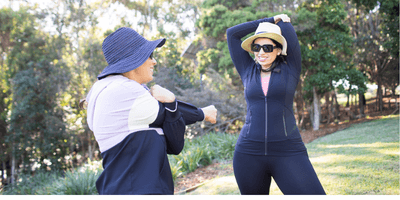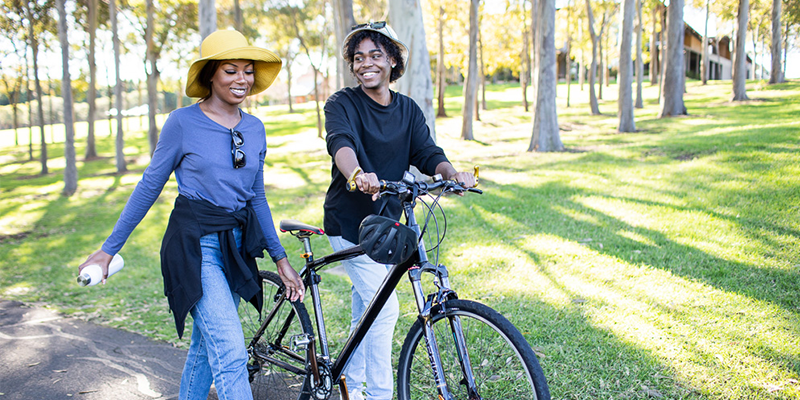Eat healthy
Go to information about:
The food you eat affects your cancer risk.
In fact, you can lower your risk of more than 10 types of cancer by making vegetables, fruit, wholegrain cereals and wholemeal foods, and legumes and beans a part of your every day diet.[1]
Eating other foods can raise your risk of cancer. Examples include processed meats and too much red meat.
An unhealthy diet can also lead to a range of health conditions.
Follow our tips on the types of foods you should include, limit and exclude in your diet every day to help reduce your risk of cancer.
Looking for general healthy eating advice?
The information on this page is about how to eat for cancer prevention.
However, the Australian Dietary Guidelines recommend eating a wide variety of foods from the five food groups every day to promote general good health and wellbeing.2
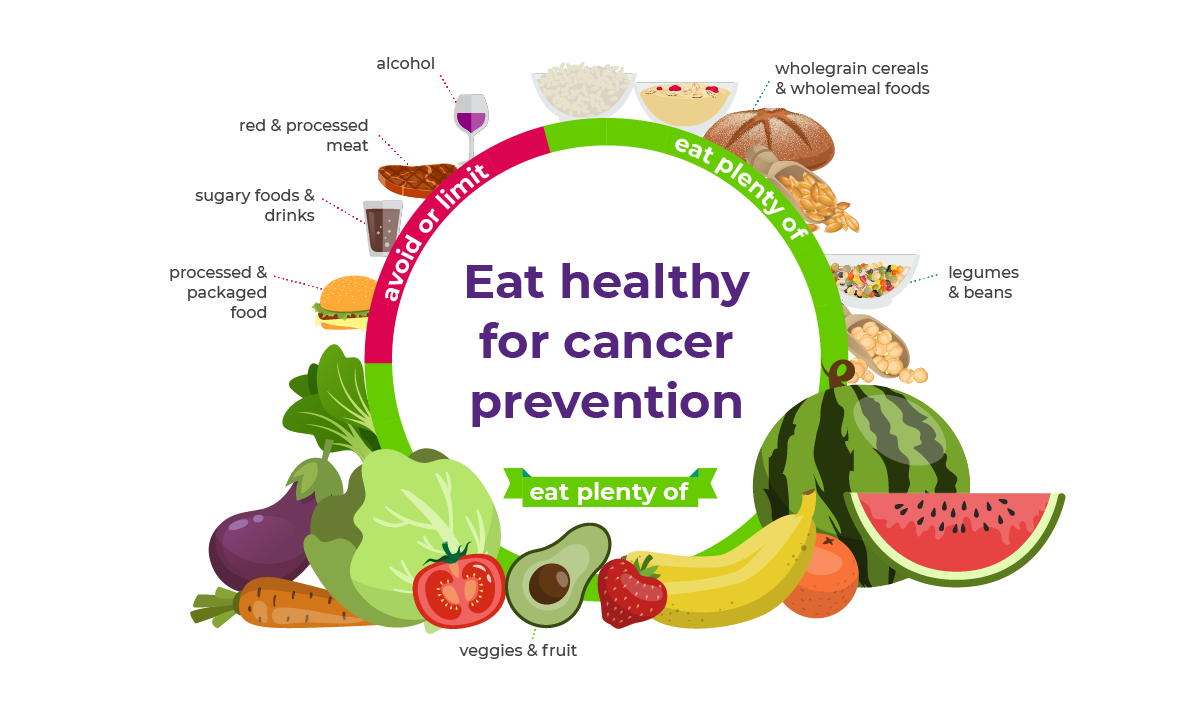
Reduce your risk of more than 10 types of cancer
Eating healthy reduces your risk of more than 10 types of cancer, including:[1]
- head and neck cancers, including the mouth and throat
- oesophageal (food pipe) cancer
- stomach cancer
- bowel cancer
- gallbladder cancer
- pancreatic cancer
- lung cancer
- ovarian cancer
- breast cancer
- prostate cancer.
Which foods should you eat for cancer prevention?
Eating a diet rich in vegetables, fruit, wholegrain cereals and wholemeal foods, and legumes and beans, can lower your risk of cancer[1] and a range of other health conditions.
Start adding or increasing these foods in your daily diet for your best dietary protection against cancer.
Eat plenty of vegetables everyday
Vegetables are rich in dietary fibre and nutrients vital to maintaining a healthy body. Make vegetables a major part of your usual daily diet to reduce the risk of mouth, throat, oesophagus, stomach and bowel cancers.

- Most adults should eat at least five serves of vegetables (75g a serve) every day.1
- Women who are pregnant or breastfeeding should eat at least 7 serves of vegetables every day.
- Children under 8 years need around 3 serves of vegetables every day.
- One serve is equal to 75g of vegetables.

- 1 handful of cooked vegetables
- 1 fist-size starchy vegetable, such as potato, sweet potato, yams, squash or taro.
- 1/2 cup of cooked vegetables, like carrot, broccoli or sweetcorn
- 1/2 cup of frozen vegetables
- 1 small potato
- 1 cup of raw celery, carrot and capsicum sticks
- ‘Eat the rainbow’— mix different coloured vegetables into your diet each day to get the benefits of a variety of nutrients and fibre.
- Prepare your vegetables in different ways - try them raw, baked, or steamed. Add seasoning, such as herbs and spices, for extra flavour.
- Make veggie soups for an easy way to consume multiple servings at once.
- Experiment with veggie noodles as a great way to get more veggies in your day. Use a spiraliser or mandoline to make zucchini noodles (zoodles), sweet potato and squash noodles. Cook them like you would pasta and eat them with sauces, other vegetables, or lean meats.
- Blend veggies into your favourite smoothie recipe. Fresh leafy, greens are common smoothie additions. You can also add avocado, cucumber and cauliflower.
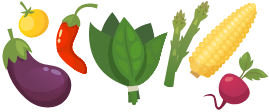
Less than 6% of people in NSW report eating adequate serves of vegetables (5 or more) each day4
Eat two serves of fruit every day
Fruit are an excellent source of essential vitamins and minerals, and are high in dietary fibre. Make fruit a part of your daily diet to reduce the risk of mouth, throat, oesophagus, stomach and bowel cancers.

- Adults should eat at least two serves of fruit every day.1
- One serve is equal to 150g of fruit.

- 1 medium apple, orange, banana or pear
- 2 small apricots, kiwi fruit, or plums
- 1 cup of diced or canned fruit (no added sugar)
- 1 cup diced melon
- 32 seedless grapes (approximately)
- 1 large peach
- 1 cup blueberries
- If you are craving something sweet, reach for a piece of fruit or make a healthy fruit smoothie.
- Choose fruits that are in-season, have a longer shelf-life and require minimal preparation. These are usually apples, bananas, grapes, pears and mandarins. They are easy to grab to eat on the go, or to pack in a lunchbox.
- Display your fruit in a bowl on your kitchen countertop as a reminder to eat your daily recommended serving.
- Top your porridge or cereal with fruits for breakfast. Or add sliced orange, mango or pear to your lunch time salad.
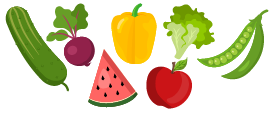
Aim to eat 2 serves of fruit and 5 serves of vegetables every day. Try eating as much fresh produce as you can - what is in season is usually affordable and tasty.
Eat wholegrain cereals and wholemeal foods every day
The dietary fibre found in wholegrain cereals and wholemeal foods ensures a healthier digestive system and can help prevent one in six bowel cancer cases. It also prevents weight gain and obesity, which increases the risk of some cancers too.
Wholegrain cereals (wholegrains) include wheat, rice corn, oats, rye, barley and millet.
Wholegrains have three layers to their grain and wholemeal foods are made from wholegrains which have been crushed to a finer texture.
White bread and white rice are examples of refined cereals which are made from only one layer of the grain and therefore contain less fibre than wholegrains or wholemeal foods.
Examples of wholegrain cereals and wholemeal foods include:
- Wholemeal or multigrain bread, muffins and crumpets
- Wholegrain or whole-wheat breakfast cereals or museli
- Wholemeal or mixed grain crisp bread
- Brown rice and brown rice cakes
- Wholemeal pasta
- Oats
- Quinoa, corn, unpearled barley, millet or amaranth
- Cracked wheat (bulgur)

- Adults under 50 years of age should eat 6 serves of mostly wholegrain cereals and wholemeal foods every day.
- Adults between 50–70 years of age, should eat 4–6 serves every day.
- Adults over 70 years of age, should eat 3 serves every day.

- 1 slice of wholemeal or wholegrain bread
- ½ cup of cooked porridge or oats
- 3 wholemeal or mixed grain crisp breads
- ½ cup or 1 cupped hand of cooked rice or quinoa
- ½ cup of cooked wholemeal pasta
- ½ cup of cooked wholegrain noodles
- Make some simple swaps: replace white rice with quinoa or brown rice, opt for buckwheat (soba) noodles over rice noodles, choose whole wheat pastas instead of white, and replace white bread with wholegrain and wholemeal varieties.
- For breakfast, opt for porridge, low-sugar Bircher muesli, or toasted whole grain bread.
- For lunch, try a wholemeal salad wrap or soup with a whole grain bread roll.
- For dinner, cook up a stir fry with buckwheat noodles, add barley to soups and casseroles, or make a salad using different grains like brown rice, wholemeal pasta or quinoa.
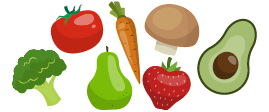
A fibre-rich diet, including 5 serves of vegetables and 2 serves of fruit a day, can help prevent 1 in 6 bowel cancer cases
Eat legumes and beans
Legumes are the seeds of particular plants. They are eaten in their immature form as green peas and green beans for example, and in their mature form as dried peas, beans, lentils and chickpeas. They can be cooked, dried or canned (preferably with no added salt).
Legumes and beans are rich in protein and iron and can be a great substitute for red meat and other protein-rich foods. They are also high in fibre which is important for reducing bowel cancer risk.
Examples include red kidney beans, soybeans (edamame), lima beans, cannellini beans, chickpeas, lentils, and split peas.

- ½ cup of cooked, dried or canned legumes/beans is equal to 1 serve of vegetables - aim to eat 5 serves of vegetables each day.
- 1 cup of cooked, dried or canned legumes/beans is equal to 1 serve of protein-rich foods - aim to eat 2–3 serves of protein-rich foods each day.
Download our printable number of serves guide (PDF) and visual serving size guide (PDF).
- Canned legumes and beans are a simple and easy meal option as they come pre-cooked and ready to eat. Simply, add a can of washed chickpeas, black beans or cannellini beans to salads, rice or stews without needing to cook them.
- Opt for chickpea or lentil pasta. There are plenty of options in your local supermarket to try that taste just as delicious as white pasta.
- Some products made from legumes and beans, such as plant-based burgers, may have added amounts of salt and sugar in them. It is a good idea to read the label of any pre-packaged food you are buying.
What foods should you limit or avoid?
Some foods increase your risk of cancer. They can also lead to weight gain, being overweight and obese, which increases your cancer risk too.
These kinds of foods are often high in fats, added sugars and added salt. You should eat these foods only sometimes (not every day) and in small amounts.
Limit red meat and avoid processed meats
There is strong evidence that red meat and processed meat (including ham, salami, bacon and frankfurts) are both causes of bowel cancer.
Eating more than the recommended amount of red meat can increase your risk of bowel, nasopharyngeal, lung, and pancreatic cancer.1
Although lean red meat can be an important source of iron, zinc, vitamin B12 and protein, eating red meat is not an essential part of a healthy diet.2 By limiting the amount of red meat you eat, you can reduce your risk of cancer.

Did you know that eating more than 455 grams of cooked red meat over a week (65 grams a day - about the size of your palm), can increase your risk of bowel cancer?1
Studies show that certain chemicals in red and processed meats – both added and naturally occurring – cause these foods to be carcinogenic (cancer causing).
Haem iron is the substance that makes meat red. When haem is broken down in the digestive system it forms chemicals that can damage cells in the bowel that can lead to cancer. Processed meat is often made from red meat and preserved by adding nitrates. Nitrates when broken-down during digestion also form chemicals that can cause cancer. Processed meat has been labelled as a Group 1 carcinogen (like tobacco smoking and asbestos) as it causes bowel cancer and may increase the risk of five other types of cancer.1 Processed meat is also high in saturated fat and salt which have been linked to some cancers.

- Red meat is any type of muscle meat from beef, veal, pork, lamb, mutton, horse and goat.
- To reduce your risk of cancer, Cancer Institute NSW recommends eating no more than 455g cooked lean red meat per week. This is 65 grams a day - about the size of your palm.
- A serving is equal to ½ cup of mince, two small chops, or two slices of lean roast meat.
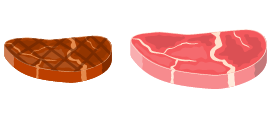
When looking at recipes it is helpful to know that 700g of raw meat becomes 455g of cooked meat.
Processed meat includes bacon, ham, devon, mortadella, corned beef (silverside), frankfurts, chorizo, cabanossi and other salami and sausages.
Cancer Institute NSW recommends avoiding processed meat, as there is strong evidence that it causes bowel cancer.
- Add more vegetables and legumes/beans to stews, curries and casseroles for a hearty, fibre and protein-rich meal.
- Substitute with a hard boiled egg, tofu or flaked tuna on your salad or sandwich.
- Use avocado instead of bacon or another processed meat. Avocado contains healthy fats and proteins. It goes well with your morning eggs. It tastes great on a sandwich too.
- Add vegetables like sweet potato and tomatoes or low-fat cheese to an omelette, instead of bacon, ham or sausage.

1 in 6 bowel cancer cases are linked to eating too much red and processed meat
Limit salt
Diets high in foods preserved by salting, such as salted fish or pickled vegetables, have been linked to an increased risk of stomach and nasopharyngeal cancer.1 Too much salt can also cause other health problems, like high blood pressure, heart disease and stroke.
You need some salt (sodium) in your diet as it helps regulate fluid levels. Although adults should eat no more than one teaspoon (6g or 2300mg) of salt a day including that contained in processed food.
Even if you do not add salt to your food, you may not be aware of just how much salt you are consuming from packaged and take-away foods such as pizza, pies, sauces, condiments, seasonings, dressings, soups, margarines, bread and breakfast cereals. It is important you check labels and choose products with less sodium (how salt can be described on food labels).
- Adults should eat no more than one teaspoon (6g) a day - including from pre-prepared food.
- Taste your food first before immediately adding salt to it.
- Try adding more flavour to your food using other ingredients such as olive oil, vinegar, spices or lemon juice.
- Choose fresh or frozen vegetables - canned vegetables tend to have salt added.
- Choose reduced salt bread and breakfast cereals. Breads and cereals are a major source of salt.
- Avoid processed foods, such as flavoured instant pasta or noodles, canned or dehydrated soup mixes, chips and salted nuts.
- Use ‘no added salt’ margarine and butter.
- Reduce the amount of soy sauce, tomato sauce and processed sauces and condiments (for example mayonnaise and salad dressings) you use on your food as they contain a lot of salt.
Limit high sugar foods and avoid sugar sweetened drinks
Foods and drinks high in sugar can increase your risk of cancer, because they can lead to weight gain, overweight and obesity. Too much sugar also increases your risk of other health problems, like type 2 diabetes and tooth decay.
Sweetened drinks are the largest source of sugars in Australian diets.3 They include soft drinks, cordials, fruit drinks, vitamin waters, and energy and sports drinks.
Sweetened foods include biscuits, cakes, jams, lollies and desserts.
When it comes to preventing cancer and maintain your health, we recommend avoiding the consumption of sugary drinks altogether and limit sweetened foods.
- Make water your drink of choice. Add some flavour with a slice of lemon, lime or orange.
- Choose wholegrain breakfast cereals. Add some fruit for sweetness instead of sugar.
- Try some natural honey to sweeten your tea and coffee.
- Grab some fruit as a snack, rather than a biscuit or a piece of cake.
- Enjoy banana or ricotta on your toast in the morning, instead of jam.
Avoid or drink less alcohol
Every drink increases your risk of getting an alcohol-related cancer. The bottom line is: there is no level of drinking that is completely safe.
- Healthy men and women should drink no more than 10 standard drinks each week and no more than four on any day.
- Anyone under 18 years of age and women who are pregnant, breastfeeding or planning a pregnancy, should not drink at all.
* Unsure of what is a standard drink? Learn how many standard drinks are in a common glass and keep track of your drinking using the Drinks Meter app.
- Commit to having a few alcohol-free days each week. Not only will you lessen your cancer risk, you will also see immediate physical and mental benefits, not to mention the cost savings.
- Set yourself a drink limit and keep track of the number of drinks you are consuming using The Drinks Meter app.
- Swap to low or no alcohol alternatives. Some popular alternatives include, soda water, non-alcoholic spirits, low or no alcohol beer, cider or wine, mocktails, kombucha and sparkling juice.
- Setting up a personal support network or finding no-drinking “buddies” can be extremely helpful to start and sustain a goal of reducing your alcohol intake. Your support network does not have to be made up of just friends or family, it could be an online community. If you find it hard to talk to friends about cutting back on alcohol, an organised community like Hello Sunday Morning, can be a good start.
** Important note: For some people, suddenly stopping drinking can make them feel physically and emotionally unwell. If you feel sick, sweaty or cannot sleep when trying to cut down on your drinking – you may be experiencing withdrawal symptoms and should see your doctor. If in doubt don’t stop drinking but seek medical advice.**
Want to learn more about reducing your alcohol intake?
Alcohol can be hard to give up, but any reduction – no matter how small or large – can reduce your risk of cancer and improve the quality of your health. Get more practical tips to start cutting down and taking steps towards a healthier future.
What is the advice on dairy?
We recognise that there is some evidence that including dairy in your diet protects against bowel cancer and lowers the risk of breast cancer (pre-menopause). However, there is also suggestive evidence dairy can increase the risk of prostate cancer.
We recommend following the Australian Dietary Guidelines for advice on how much dairy you should be including in your daily diet.
What about poultry and eggs?
We have not included guidelines on eating poultry and eggs as the information on this page is specifically about eating for cancer prevention.
Poultry, eggs and fish are valuable sources of protein and micronutrients, and are great substitutes for red meat if you are trying to limit your intake for cancer prevention.
For more information on how much to include in your daily diet for general health and wellbeing, visit the Australian Dietary Guidelines.
More information and resources
- Download our printable factsheets on eating healthy for cancer prevention. Stick them on your fridge and share them with you friends or family members as a quick and easy daily reminder:
- Healthy Eating Active Living is a NSW Government website with healthy eating tips and information on free programs to get you active. It aims to help you live a healthier life through food and exercise.
- Get Healthy NSW offers free health coaching over the phone to help you reach your health goals and reduce your alcohol consumption
- The Australian Dietary Guidelines tell you what foods to eat and how much. They also tell you what foods to avoid.
- Use this food calculator to help you achieve balance in your diet and how to eat healthy for your age and gender.
- Check out this lunchbox tool by the Cancer Council to help you learn how to pack a healthy lunch for both adults and children.
- Your Room is a great place to get facts about alcohol, how it affects your body and more.
- The Staying well and preventing cancer flipchart was developed for community educators supporting multicultural communities. It starts the conversation around cancer prevention and healthy living behaviours including healthy eating, being active, being a healthy body weight, not smoking, protecting your skin and participating in cancer screening.
1. World Cancer Research Fund Australian Institute for Cancer Research. Diet, Nutrition, Physical Activity and Cancer: a Global Perspective. Continuous Update Project Exert Report 2018. Available from dietandcancerreport.org
2. National Health and Medical Research Council (2013) Australian Dietary Guidelines. Canberra: National Health and Medical Research Council.
3. Australian Bureau of Statistics, 2016. ‘Australian Healthy Survey: Consumption of added sugars, 2011-12’. Available from Australian Bureau of Statistics https://www.abs.gov.au/ausstats
4. NSW Government HealthStats NSW, fruit and vegetable consumption. Available from http://www.healthstats.nsw.gov.au/Indicator/beh_veg_statage. (Accessed 17 August 2020)

